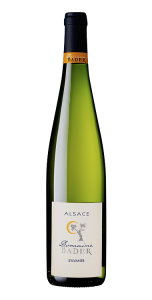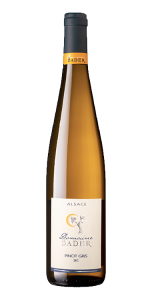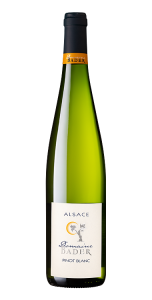A vintage at odds with the last two decades
At Domaine Bader, in Epfig (Alsace), the 2024 harvest is in and the wines are quietly finishing their fermentation.
Here we talk to Pierre Scharsch about the vintage and the various challenges it posed.


October 2024
Epfig, Alsace
What has the weather been like since our last visit on 15 August?
‘The vintage ended as it began, in the rain,’ warns Pierre. Indeed, 2024 will be marked by an all-time record for rainfall. In Strasbourg, the month of May even reached record levels, becoming the wettest since the first Météo France records began in 1922!
However, despite the mildew pressure that affected the Pinot Noir and Pinot Gris vines, the impact on most of the vintages was fairly positive. A few days of fine weather in August enabled the grapes to reach a sufficient level of ripeness, making the wines lower in alcohol, with 0.5 to 1 degree of alcohol less than average, and a lovely natural freshness.
A year that breaks the cycle of the last two decades, marked by global warming, and which had produced increasingly concentrated wines with less acidity.
These breakthrough vintages seem to be an integral part of the new ‘normal’, like 2021 and 2016.

Fermentations are nearly over
What impact will this have on harvest dates?
The harvest window was particularly short this year (apart from the late harvests, of course, of which one Gewurztraminer parcel will be harvested in November), which added extra pressure on the teams.
Harvesting began on 12 September for the crémants and continued uninterrupted until 1 October. The risk of further precipitation prompted Pierre, exceptionally, to pick a few plots by machine to save time, as he says he ‘prefers to pick healthy grapes by machine rather than rotten ones by hand’.
So it was a succession of sleepless nights with mechanical harvesting and days harvesting by hand, for a season that was tiring but relatively satisfactory from a quality point of view, over a much shorter period than usual.


The order of harvest dates for the different grape varieties remained in phase with the natural cycle of the vine: Crémant / Pinot Blanc / Pinot Gris / Pinot Noir / Muscat / Riesling & Gewurztraminer.
A vintage of quality, but also quantity?
Although most grape varieties produced less than usual, mainly because of the pressure of mildew and heavy rainfall, the rain also enabled some vines to form larger bunches to balance out the losses, and Pierre says he harvested more than he had hoped from his Spring projections, which was too cool and damp.
The Pinot Noir and Pinot Gris suffered from mildew, yielding half a normal crop. The generosity of the 2023 vintage for these grape varieties is helping to balance out the quantities in stock. Please note: Pinot Noir from the Fronholz Cru will not be produced in 2024, as the quantities of grapes were too small and were incorporated into the estate’s generic Pinot Noir.
Can we make a comparison with a previous vintage?
The break in the dynamics of global warming is reminiscent of cooler, wetter vintages, such as 2021 and 2016. On the other hand, the phenomenon was much more marked in 2024.
This is reflected in the style of the wines, with a natural lightness that runs counter to the higher concentrations of sunnier years, and a slightly lower alcohol content, but some fine aromas all the same, particularly in the Muscat, which Pierre finds magnificent this year.

All these wines will be available from the summer of 2025, and we’ll have to wait until the Spring of 2026 for the crémant.

List of the wines available at the estate

Sylvaner 2023
Dry and fresh
Floral nose and refreshing mouth
Easy to pair with shellfish, delicatessen, salads, fish.
Ageing potential : 2 to 3 years
Pinot Gris 2023
Rich and powerful
The nose offers a subtle palette of dried fruit notes, yellow fruits and roasting. The palate reveals an ample and warm wine. Wishing to offer a gourmet Pinot Gris, its roundness is discreet.
This wine finds a place at the table with meat appetizers, mushroom dishes, duck and veal.
Ageing potential: 3 to 5 years


Pinot Blanc 2023
Dry and fruity
Nice fruity nose, slightly brioched. rich and supple on the palate.
It easily accompanies many simple and convivial dishes, quiches, pies, cold buffets, flamed pies.
Ageing potential: 2 to 3 years
Riesling 2023
Dry, fruity and mineral
The nose of a beautiful finesse evokes citrus and minerality. The palate, long and structured, is sustained by a beautiful liveliness.
Gastronomic wine with its structure and finesse, Riesling goes well with seafood, fish and white meats.
Ageing potential: 3 to 5 years


Pinot Noir 2023
Supple and crunchy
Nose with notes of black cherry and toasted notes. The palate is structured by fine tannins and a delicately juicy finish. As a good light red wine, it will not disappoint you by accompanying a barbecue, charcuterie or a grilled chicken.
Ageing potential: 5 years.
Crémant
Our crémant grapes come from Chardonnay and Pinot Noir vines, sheltered under the village, on a deep loamy soil that gives fruitiness and smoothness. Our Crémant d’Alsace brut (raw), with a nose of mirabelle and fresh butter, is singular by the nobility of its bubbles.
The “brut” dosage leaves a great liveliness in the mouth.
Ideal as an aperitif, during a cold buffet, or to refresh a meal end
To guard: 3 to 5 years


Riesling Erdengott
The wine comes from the plot Fronholz, planted in 1947 at the top of the hill ventilated with a south-west exposure. In surface you find mostly sand, and deep underground, you can find of sandstone and clay that only the age of the vines allows to express through a fine minerality.
Like most of the greatest mineral Rieslings, this wine show its bright typicity through citrus fruit and flint notes. On the palate, it acknowledges a nice gastronomic wines, with a saline and delicate acidicty.
Ageing potential: 8 to 10 years